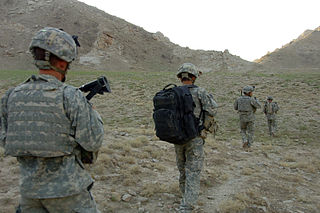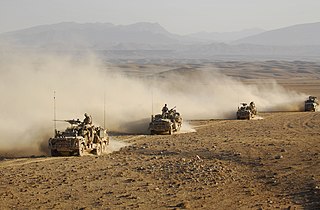Related Research Articles

The Special Air Service (SAS) is a special forces unit of the British Army. It was founded as a regiment in 1941 by David Stirling, and in 1950 it was reconstituted as a corps. The unit specialises in a number of roles including counter-terrorism, hostage rescue, direct action and special reconnaissance. Much of the information about the SAS is highly classified, and the unit is not commented on by either the British government or the Ministry of Defence due to the secrecy and sensitivity of its operations.

The Security Service, also known as MI5, is the United Kingdom's domestic counter-intelligence and security agency and is part of its intelligence machinery alongside the Secret Intelligence Service (MI6), Government Communications Headquarters (GCHQ), and Defence Intelligence (DI). MI5 is directed by the Joint Intelligence Committee (JIC), and the service is bound by the Security Service Act 1989. The service is directed to protect British parliamentary democracy and economic interests and to counter terrorism and espionage within the United Kingdom (UK).

The Special Boat Service (SBS) is the special forces unit of the United Kingdom's Royal Navy. The SBS can trace its origins back to the Second World War when the Army Special Boat Section was formed in 1940. After the Second World War, the Royal Navy formed special forces with several name changes—Special Boat Company was adopted in 1951 and re-designated as the Special Boat Squadron in 1974—until on 28 July 1987 when the unit was renamed as the Special Boat Service after assuming responsibility for maritime counter-terrorism. Most of the operations conducted by the SBS are highly classified, and are rarely commented on by the British government or the Ministry of Defence, owing to their sensitive nature.

The 1st Special Forces Operational Detachment–Delta, referred to variously as Delta Force, Combat Applications Group (CAG), or within Joint Special Operations Command (JSOC), Task Force Green, is a special operations force of the United States Army, under operational control of JSOC. The unit's missions primarily involve counterterrorism, hostage rescue, direct action, and special reconnaissance, often against high-value targets.

The Special Activities Center (SAC) is a division of the United States Central Intelligence Agency responsible for covert and paramilitary operations. The unit was named Special Activities Division (SAD) prior to 2015. Within SAC there are two separate groups: SAC/SOG for tactical paramilitary operations and SAC/PAG for covert political action.
A security agency is a governmental organization that conducts intelligence activities for the internal security of a nation. They are the domestic cousins of foreign intelligence agencies, and typically conduct counterintelligence to thwart other countries' foreign intelligence efforts.

Long-range surveillance (LRS) teams were elite, specially-trained surveillance units of the United States Army employed for clandestine operation by Military Intelligence for gathering direct human intelligence information deep within enemy territory. Classic LRS employment is to infiltrate deep into enemy territory, construct hide and surveillance sites, and provide continuous surveillance/special reconnaissance of an intelligence target of key interest.

The Special Reconnaissance Regiment (SRR) is a tier 1 special reconnaissance unit of the British Army. It was established on 6 April 2005 and is part of the United Kingdom Special Forces (UKSF).

The Directorate of Operations (DO), less formally called the Clandestine Service, is a component of the US Central Intelligence Agency. It was known as the Directorate of Plans from 1951 to 1973; as the Directorate of Operations from 1973 to 2005; and as the National Clandestine Service (NCS) from 2005 to 2015.

The Special Forces Support Group (SFSG) is a special forces unit of the British Armed Forces. The SFSG was formed officially on 3 April 2006 to provide support to the Special Air Service, the Special Boat Service and the Special Reconnaissance Regiment on operations. It is a tri-service unit, composed of the 1st Battalion, The Parachute Regiment, a company of Royal Marine Commandos, and a flight (platoon) from the Royal Air Force Regiment.

The special forces of the Australian Defence Force are units of Special Operations Command and associated units of the Royal Australian Navy and the Royal Australian Air Force that conduct and or support special operations to advance and protect the national security of the Commonwealth of Australia. The special forces of Australia have a lineage to a variety of units raised in the Second World War such as the Independent and Commando Companies, Z Special Unit, Navy Beach Commandos, and the Coastwatchers. Australian special forces have most recently been deployed to Iraq in Operation Okra as the Special Operations Task Group, as the Special Operations Task Group in Afghanistan, in Afghanistan in support of the Australian Secret Intelligence Service and regularly for counter-terrorism pre-deploy to locations of major domestic events throughout Australia in readiness to support law enforcement such as the 2014 G20 Brisbane summit.
The history of the British Army's Special Air Service (SAS) regiment of the British Army begins with its formation during the Western Desert Campaign of the Second World War, and continues to the present day. It includes its early operations in North Africa, the Greek Islands, and the Invasion of Italy. The Special Air Service then returned to the United Kingdom and was formed into a brigade with two British, two French and one Belgian regiment, and went on to conduct operations in France, Italy again, the Low Countries and finally into Germany.

Special reconnaissance (SR) is conducted by small units, such as a recon team, made up of highly trained military personnel, usually from special forces units and/or military intelligence organizations. Special reconnaissance teams operate behind enemy lines, avoiding direct combat and detection by the enemy. As a role, SR is distinct from commando operations, but both are often carried out by the same units. The SR role frequently includes covert direction of airstrikes and indirect fire, in areas deep behind enemy lines, placement of remotely monitored sensors, and preparations for other special forces. Like other special forces, SR units may also carry out direct action and unconventional warfare, including guerrilla operations.
National governments deal in both intelligence and military special operations functions that either should be completely secret, or simply cannot be linked to the sponsor. It is a continuing and unsolved question for governments whether clandestine intelligence collection and covert action should be under the same agency. The arguments for doing so include having centralized functions for monitoring covert action and clandestine HUMINT and making sure they do not conflict, as well as avoiding duplication in common services such as cover identity support, counterespionage, and secret communications. The arguments against doing so suggest that the management of the two activities takes a quite different mindset and skills, in part because clandestine collection almost always is on a slower timeline than covert action.
The Special Reconnaissance Unit, also known as the 14 Field Security and Intelligence Company was a part of the British Army Intelligence Corps involved in plainclothes operations in Northern Ireland from the 1970s onwards.
Matthew Howard Dunn is a British spy novelist, media talent, creative adviser, and former MI6 intelligence officer. According to his publicists his time in the intelligence services included experience with specialized units of the British SAS and SBS as well as joint operations with MI5, GCHQ, the CIA, and BND.

The Secret Intelligence Service (SIS), commonly known as MI6, is the foreign intelligence service of the United Kingdom, tasked mainly with the covert overseas collection and analysis of human intelligence on foreign nationals in support of its Five Eyes partners. SIS is one of the British intelligence agencies and the Chief of the Secret Intelligence Service ("C") is directly accountable to the Foreign Secretary.

The Special Group (SG) is the special forces unit of the Research and Analysis Wing, India’s foreign intelligence agency. It is responsible for covert and paramilitary operations and is known as 4 Vikas, 22 SF and 22 SG. Its responsibilities include conducting operations with which the Government of India may not wish to be overtly associated.

Though not officially a belligerent during the Soviet–Afghan War, the United Kingdom was heavily involved, playing a key covert role in the conflict. Also known as the Second Great Game, the British provided both indirect and direct support for the Afghan mujahideen in their fight against the Soviet Union, including secretly arming, funding and supplying various factions. Britain's Secret Intelligence Service (MI6) primarily supported the Mujahideen group Jamiat-e Islami, commanded by Ahmad Shah Massoud who, having received little support from the US and Pakistan, became Britain's key ally in the conflict. Fighting in the Panjshir valley, Massoud and his fighters with British support and intelligence, overcame nine Soviet offensives and held out up to the Soviet withdrawal from the vital valley in 1986. Massoud became the most successful and feared out of any of the Mujahideen commanders.
References
- 1 2 Urban, Mark (19 January 2012). "Inside story of the UK's secret mission to beat Gaddafi". BBC News. Archived from the original on 20 Sep 2020. Retrieved 20 Sep 2020.
- 1 2 Neville, Leigh (2015). Special Forces in the War on Terror. Osprey Publishing. p. 296. ISBN 9781472807908.
- 1 2 3 Ryan, Chris (31 July 2012). "The Increment - is it real?". Chris Ryan's Official Blog.
- 1 2 3 4 Tomlinson, Richard (2001). The Big Breach. Moscow, Russia: Narodny Variant Publishers. pp. 26, 48. ISBN 9780970554789.
- 1 2 3 Tweedie, Neil (18 October 2011). "Meet the spy who is harder than James Bond". The Telegraph. Retrieved 15 October 2022.
- 1 2 Bennett, Richard M. (13 June 2003). "Assassination and the License to Kill". Asia Times Online. Please note that the full article text only seems to be available on the page linked, under "Annex", which is a memorandum from Dr Martha Mundy titled 'Memorandum from Dr Martha Mundy' addressed to the UK Parliament. Retrieved 15 October 2022.
- ↑ Atlamazoglou, Stavros (22 June 2021). "A British army email mishap publicly mentioned a military intel unit so secretive its members are banned from social media". Business Insider. Retrieved 5 February 2023.
- ↑ Davies, Philip H. J. (2000). "From special operations to special political action: The 'rump SOE' and SIS post‐war covert action capability 1945–1977". Intelligence and National Security. 15 (3): 63, 64. doi:10.1080/02684520008432617 – via Taylor & Francis Online.
- ↑ Davies, Philip H. J. (2004). MI6 and the Machinery of Spying. Routledge. p. 313. ISBN 9780714683638.
- ↑ Dunn, Matthew Howard. "Biography". Matthew Dunn Books. Matthew Howard Dunn's own website/blog. Archived from the original on 16 Feb 2015. Retrieved 15 October 2022.
- ↑ "About the Author: Matthew Dunn". AbeBooks. 15 October 2022. Retrieved 15 October 2022.
- ↑ About the Author: Matthew Dunn. 15 October 2022. ASIN 1409124762.
- ↑ "Author's Bio: Matthew Dunn". Wheelers Books. Under "Author's Bio". 15 October 2022. Retrieved 15 October 2022.
{{cite web}}: CS1 maint: others (link) - ↑ Spy Secrets: Playing Dirty (2003), Produced by Carole Peters. Broadcast on British television, probably Channel 4.